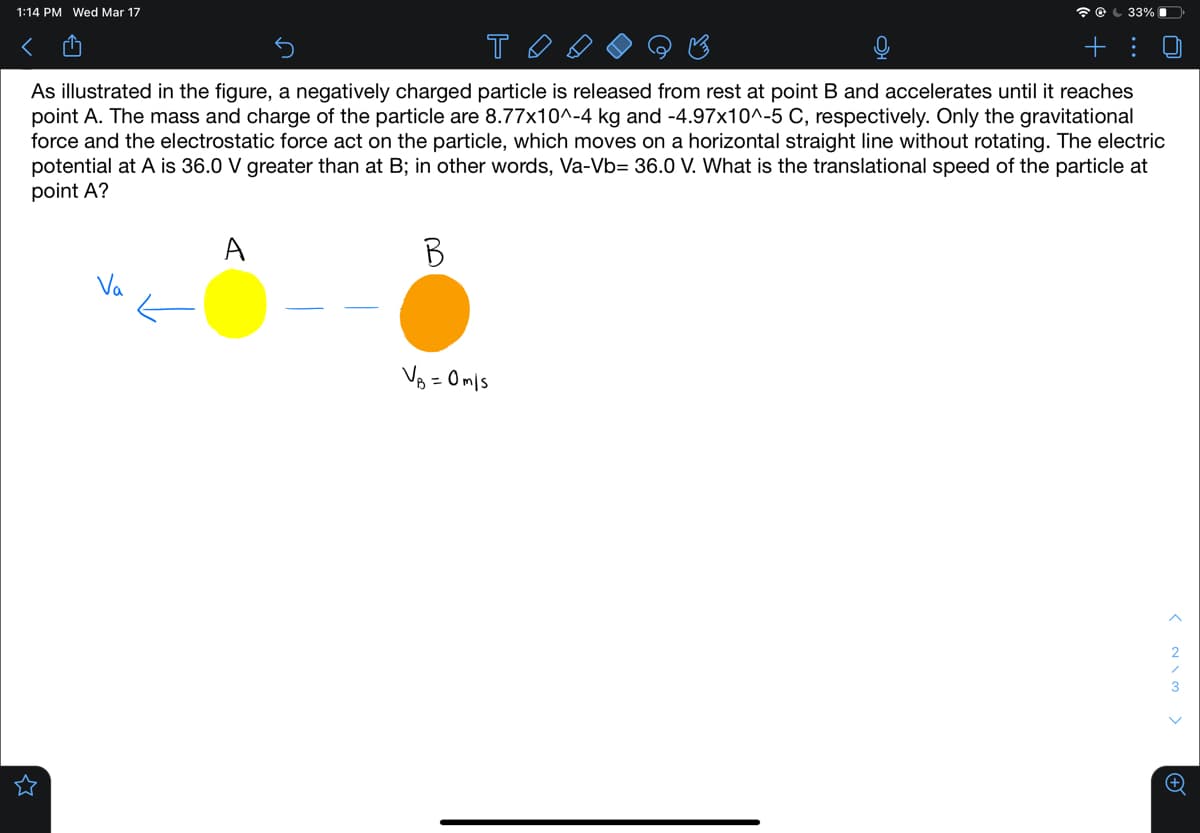illustrated in the figure, a negatively charged particle is released from rest at point B and accelerates until it reaches point A. The mass and charge of the particle are 8.77x10^-4 kg and -4.97x10^-5 C, respectively. Only the gravitational force and the electrostatic force act on the particle, which moves on a horizontal straight line without rotating. The electric potential at A is 36.0 V greater than at B; in other words, Va-Vb= 36.0 V. What is the translational speed of the particle at point A?
illustrated in the figure, a negatively charged particle is released from rest at point B and accelerates until it reaches point A. The mass and charge of the particle are 8.77x10^-4 kg and -4.97x10^-5 C, respectively. Only the gravitational force and the electrostatic force act on the particle, which moves on a horizontal straight line without rotating. The electric potential at A is 36.0 V greater than at B; in other words, Va-Vb= 36.0 V. What is the translational speed of the particle at point A?
College Physics
10th Edition
ISBN:9781285737027
Author:Raymond A. Serway, Chris Vuille
Publisher:Raymond A. Serway, Chris Vuille
Chapter16: Electrical Energy And Capacitance
Section16.2: Electric Potential And Potential Energy Due To Point Charges
Problem 16.6QQ: A spherical balloon contains a positively charged particle at its center. As the balloon is inflated...
Related questions
Question
As illustrated in the figure, a negatively charged particle is released from rest at point B and accelerates until it reaches point A. The mass and charge of the particle are 8.77x10^-4 kg and -4.97x10^-5 C, respectively. Only the gravitational force and the electrostatic force act on the particle, which moves on a horizontal straight line without rotating. The electric potential at A is 36.0 V greater than at B; in other words, Va-Vb= 36.0 V. What is the translational speed of the particle at point A?

Transcribed Image Text:1:14 PM Wed Mar 17
33% D
+ :
As illustrated in the figure, a negatively charged particle is released from rest at point B and accelerates until it reaches
point A. The mass and charge of the particle are 8.77x10^-4 kg and -4.97x10^-5 C, respectively. Only the gravitational
force and the electrostatic force act on the particle, which moves on a horizontal straight line without rotating. The electric
potential at A is 36.0 V greater than at B; in other words, Va-Vb= 36.0 V. What is the translational speed of the particle at
point A?
A
B
Vg = O mls
%3D
3
Expert Solution
This question has been solved!
Explore an expertly crafted, step-by-step solution for a thorough understanding of key concepts.
This is a popular solution!
Trending now
This is a popular solution!
Step by step
Solved in 2 steps with 2 images

Knowledge Booster
Learn more about
Need a deep-dive on the concept behind this application? Look no further. Learn more about this topic, physics and related others by exploring similar questions and additional content below.Recommended textbooks for you

College Physics
Physics
ISBN:
9781285737027
Author:
Raymond A. Serway, Chris Vuille
Publisher:
Cengage Learning

College Physics
Physics
ISBN:
9781305952300
Author:
Raymond A. Serway, Chris Vuille
Publisher:
Cengage Learning

Physics for Scientists and Engineers, Technology …
Physics
ISBN:
9781305116399
Author:
Raymond A. Serway, John W. Jewett
Publisher:
Cengage Learning

College Physics
Physics
ISBN:
9781285737027
Author:
Raymond A. Serway, Chris Vuille
Publisher:
Cengage Learning

College Physics
Physics
ISBN:
9781305952300
Author:
Raymond A. Serway, Chris Vuille
Publisher:
Cengage Learning

Physics for Scientists and Engineers, Technology …
Physics
ISBN:
9781305116399
Author:
Raymond A. Serway, John W. Jewett
Publisher:
Cengage Learning

Principles of Physics: A Calculus-Based Text
Physics
ISBN:
9781133104261
Author:
Raymond A. Serway, John W. Jewett
Publisher:
Cengage Learning

Physics for Scientists and Engineers
Physics
ISBN:
9781337553278
Author:
Raymond A. Serway, John W. Jewett
Publisher:
Cengage Learning

Physics for Scientists and Engineers with Modern …
Physics
ISBN:
9781337553292
Author:
Raymond A. Serway, John W. Jewett
Publisher:
Cengage Learning